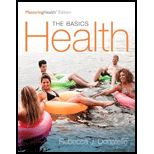
Health: The Basics, The Mastering Health Edition (12th Edition)
12th Edition
ISBN: 9780134183268
Author: Rebecca J. Donatelle
Publisher: PEARSON
expand_more
expand_more
format_list_bulleted
Question
Chapter 13, Problem 6PQ
Summary Introduction
To discuss: The type of environment which sexually transmitted infection pathogens preferred
Introduction:
The sexually transmitted infections are widely spread through sexual intercourse, mostly through vaginal, oral and anal intercourse. The major symptoms are abnormal vaginal and penile discharges and ulcers around genitals.
Expert Solution & Answer
Want to see the full answer?
Check out a sample textbook solution
Chapter 13 Solutions
Health: The Basics, The Mastering Health Edition (12th Edition)
Ch. 13 - Prob. 1WDYTCh. 13 - What actions can you take to reduce your risks?Ch. 13 - Prob. 3WDYTCh. 13 - Prob. 4WDYTCh. 13 - Prob. 5WDYTCh. 13 - Prob. 6WDYTCh. 13 - Prob. 7WDYTCh. 13 - Prob. 8WDYTCh. 13 - Prob. 9WDYTCh. 13 - Prob. 10WDYT
Ch. 13 - Prob. 11WDYTCh. 13 - Prob. 12WDYTCh. 13 - What actions can you take to reduce your risks?Ch. 13 - Prob. 1PQCh. 13 - Prob. 2PQCh. 13 - Prob. 3PQCh. 13 - Prob. 4PQCh. 13 - Prob. 5PQCh. 13 - Prob. 6PQCh. 13 - Prob. 7PQCh. 13 - Prob. 8PQCh. 13 - Prob. 9PQCh. 13 - Prob. 10PQCh. 13 - LO 1 | The Process of Infection 1 What are three...Ch. 13 - Prob. 2TAICh. 13 - Prob. 3TAICh. 13 - Prob. 4TAICh. 13 - Prob. 5TAICh. 13 - Prob. 6TAICh. 13 - LO 5 | Common Types of Sexually Transmitted...Ch. 13 - Prob. 8TAICh. 13 - You can always tell when youve got an STI because...Ch. 13 - Some STis can be passed on by skin-to-skin contact...Ch. 13 - Prob. 3AYCh. 13 - Oral sex is safe sex.Ch. 13 - Prob. 5AYCh. 13 - As long as you dont have anal intercourse, you...Ch. 13 - All sexually active females should have a regular...Ch. 13 - Once genital warts have been removed, there is no...Ch. 13 - You can get several STIs at one time.Ch. 13 - Prob. 10AYCh. 13 - Prob. 11AYCh. 13 - All STIs can be cured.Ch. 13 - You can get an STI more than once.Ch. 13 - Prob. 1PQACh. 13 - Prob. 2PQACh. 13 - Prob. 3PQACh. 13 - Prob. 4PQACh. 13 - Prob. 5PQA
Knowledge Booster
Learn more about
Need a deep-dive on the concept behind this application? Look no further. Learn more about this topic, health-nutrition and related others by exploring similar questions and additional content below.Similar questions
- Allergy to pollen is classified as _______. a. an autoimmune reaction b. immunodeficiency c. delayed hypersensitivity d. immediate hypersensitivityarrow_forwardThe form of pneumonia that can be prevented through vaccination is ______________________. bacterial pneumonia viral pneumoniaarrow_forwardRobert Koch (a) proposed a set of guidelines to demonstrate that a specific pathogen causes specific disease symptoms (b) discovered Helicobacter (c) showed that biofilms consist of microorganisms (d) proposed a hypothesis for antibiotic resistance (e) demonstrated that people can be stimulated to develop immunity to diseasearrow_forward
arrow_back_ios
arrow_forward_ios
Recommended textbooks for you
 Comprehensive Medical Assisting: Administrative a...NursingISBN:9781305964792Author:Wilburta Q. Lindh, Carol D. Tamparo, Barbara M. Dahl, Julie Morris, Cindy CorreaPublisher:Cengage LearningBasic Clinical Lab Competencies for Respiratory C...NursingISBN:9781285244662Author:WhitePublisher:Cengage
Comprehensive Medical Assisting: Administrative a...NursingISBN:9781305964792Author:Wilburta Q. Lindh, Carol D. Tamparo, Barbara M. Dahl, Julie Morris, Cindy CorreaPublisher:Cengage LearningBasic Clinical Lab Competencies for Respiratory C...NursingISBN:9781285244662Author:WhitePublisher:Cengage- Essentials of Pharmacology for Health ProfessionsNursingISBN:9781305441620Author:WOODROWPublisher:Cengage

Comprehensive Medical Assisting: Administrative a...
Nursing
ISBN:9781305964792
Author:Wilburta Q. Lindh, Carol D. Tamparo, Barbara M. Dahl, Julie Morris, Cindy Correa
Publisher:Cengage Learning


Basic Clinical Lab Competencies for Respiratory C...
Nursing
ISBN:9781285244662
Author:White
Publisher:Cengage



Essentials of Pharmacology for Health Professions
Nursing
ISBN:9781305441620
Author:WOODROW
Publisher:Cengage
Bacterial Infections in Humans; Author: Professor Dave Explains;https://www.youtube.com/watch?v=FeFKAl9KyMg;License: Standard Youtube License